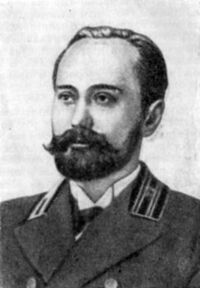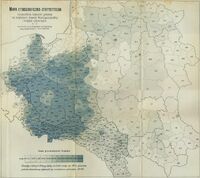Biography:Henryk Merczyng
Henryk Merczyng | |
|---|---|
 | |
| Born | 5 February 1860 Zgierz, Congress Poland, Russian Empire |
| Died | 14 September 1916 (aged 56) Petrograd, Russian Empire |
| Other names | Edward Czyński |
| Citizenship | Russian |
| Alma mater | Imperial University of Warsaw, St. Petersburg Institute of Communication Engineers |
| Scientific career | |
| Fields | Electrical engineering |
| Institutions | St. Petersburg Institute for Communication Engineers, St. Petersburg Electrotechnical Institute, Russian Ministry of Communication |
Henryk Merczyng (Russian: Генрих Карлович Мерчинг, alias Edward Czyński; 5 February 1860 – 14 September 1916) was a physicist, professor of electrical engineering at St. Petersburg Institute of Communication Engineers, pioneer of railway electrification projects, amateur historian and demographer.
Biography
Merczyng was born on 5 February 1860 in Zgierz, Russian Empire (now Poland ) to a Calvinist family of Jan Karol Merczyng, a known architect and builder from Łęczyca County, and Matylda née Schlabic.[1] He graduated with honors from the Faculty of Physics and Mathematics at the Imperial University of Warsaw (1882) and continued his education at the St. Petersburg Institute of Communication Engineers. After finishing his studies in 1885, he worked at the Novaja Alexandrija station (now Puławy) and in 1887 began teaching at his alma mater in St. Petersburg.[1][2]
Physicist and engineer
In 1890 Merczyng started lecturing on electrical engineering and telegraphy, and organized an electrotechnical laboratory. Since 1892 he was employed as an adjunct professor. He became an associate professor in 1896 and was granted full professorship in electrical engineering in 1904. He also taught for some time at the St. Petersburg Electrotechnical Institute. During his career as a professor, he supervised some of the first diploma theses on the subjects of electric power systems (tramway, railway, and hydropower) and electrification of rolling stock repair plants.[2]
Merczyng was the main initiator of Russian railways electrification plans and developed pioneering projects in this area: the St. Petersburg junction, the Transcaucasus railways (1911), and the Moscow junction (1912). He was a member of the engineering council of the Russian Ministry of Communication[2] and a State Councillor.[3]
Some of his research dealt with hydraulics, in particular, the theory of fluid flow through pipelines, and was done in connection with the long-distance Baku-Batumi oil pipeline that was being built at the time. He also conducted comprehensive studies and experiments in the field of optics and light waves.[2]
Merczyng was an active member of the Polish colony in St. Petersburg and in 1883 founded (together with Władysław Natanson) a semi-legal organization for Polish students, which after 1905 evolved into the legal Association of Polish Physicians and Naturalist (Polish: Związek Polskich Lekarzy i Przyrodników). He also belonged to the Management Board of Polish Higher Courses in St. Petersburg.[2]
Historian and demographer

Merczyng took particular interest in the history of reformation in Poland, issues of demography and historical geography. He devoted himself to these disciplines mainly on holidays while frequenting libraries and archives both in the Russian Empire and Austrian Galicia.[2] In 1887 he authored his "Ethnographical-Statistical Outline of the Numerical Strength and Distribution of the Polish Population" (Polish: Etnograficzno-statystyczny zarys liczebności i rozsiedlenia ludności polskiej), which was republished with changes in 1909. The new edition included significantly different data for the Russian Empire's territory – the first version relied on church statistics, while the second repeated results of the 1897 Russian census.[5][6][4]
Merczyng was one of the pioneers of research on the history of Polish nontrinitarianism. His works on the Polish Reformation movement are valued mainly due to the large number of primary sources employed, many of which are now lost or no longer available.[2] Among his most important publications are: "Zbory i senatorowie protestanccy w dawnej Polsce" (1904)[2] (Protestant churches and senators in old Poland) and "Zbiór pomników reformacji kościoła polskiego i litewskiego" (Monumenta Reformationis Polonicae et Lithuanicae) (1911).
Merczyng and Jan Jakubowski mathematically analyzed and described prince Radziwiłł's 17th-century map of Grand Duchy of Lithuania.[7]
Selected works
- "O własnościach ogniskowych siatek dyfrakcyjnych" (1882) (On focal properties of diffraction gratings)
- Mikołaj Kopernik. Życie i działalność naukowa (1888) (Nicolaus Copernicus. Life and scientific activity)
- "Zasady elektrotechniki" (1889) (Principles of electrotechnology)
- "Dumania przyrodnika" (1900) (Reflections of the naturalist)
- "Teorya prądu elektrycznego. Zarys zasadniczych praw ustalonego i nieustalonego prądu elektrycznego i towarzyszących mu zakłóceń magnetycznych. Podstawy elektromagnetycznej teoryi światła" (1905) (Electricity theory. Outline of the basic laws of established and unknown electric current and accompanying magnetic disturbances. Principles of electromagnetic theory of light)
- "Podręcznik matematyczny szkół polskich za Zygmunta III" (1907) (Mathematics manual for Polish schools during rule of Sigismund III)
- "The Unitarian movement in Poland from 1560-1660", International Congress of Free Christianity and Religious Progress (5th: 1910: Berlin, Germany)
- "O zasadzie względności w pojęciu fizycznym czasu i przestrzeni. Hipotezy Lorentza i Einsteina" (1911) (On the principle of relativity in the physical meaning of time and space[8])
- "Mapa Litwy z r. 1613 ks. Radziwiłła Sierotki pod względem matematycznym i kartograficznym" (1913) (Prince Radziwiłł's 1613 map of Lithuania from mathematical and cartographic point of view)
- "Szymon Budny jako krytyk tekstów biblijnych" (1913) (Szymon Budny as critic of biblical texts)
References
- ↑ 1.0 1.1 Zuzga, Włodzimierz (1987). "Henryk Merczyng. Życie i działalność naukowa" (in pl). Kwartalnik Historii Nauki I Techniki (PAN) 32 (3–4): 692. ISSN 0023-589X.
- ↑ 2.0 2.1 2.2 2.3 2.4 2.5 2.6 2.7 Kubiatowski, Jerzy; Tazbir, Janusz (1975). "Henryk Merczyng" (in pl). Polski Słownik Biograficzny (Polish Biographical Dictionary). Vol.20. PAN. https://www.ipsb.nina.gov.pl/a/biografia/henryk-merczyng.
- ↑ "Artificial lighting of country roads, by H. Merczyng". The Surveyor and Municipal Engineer (St. Bride's Press) 43: 999. 1913.
- ↑ 4.0 4.1 Maliszewski, Edward (1916) (in pl). Polskość i Polacy na Litwie i Rusi (2nd ed.). PTKraj. pp. 13–14. http://pbc.biaman.pl/dlibra/docmetadata?id=1973&from=publication.
- ↑ Eberhardt, Piotr (2010). "Osiągnięcia naukowe polskiej geografii narodowości" (in pl). Czasopismo Geograficzne (Geographical Journal) (PTG) 81 (3): 141. ISSN 0071-8076.
- ↑ Zatko, James T.. "The Catholic Church and the Russian Statistics 1804 - 1917". The Polish Review (University of Illinois Press) 5 (1): 39. ISSN 0032-2970.
- ↑ Török, Zsolt (2007). "Renaissance Cartography in East-Central Europe, ca. 1450–1650". in Woodward, David. The history of cartography. Cartography in the European Renaissance. University of Chicago Press. p. 1808.
- ↑ Średniawa, Bronisław (1987). "The reception of theory of relativity in Poland". in Glick, Thomas F.. The Comparative Reception of Relativity. D. Reidel Publishing Company. p. 322. ISBN 978-94-010-8223-5.

